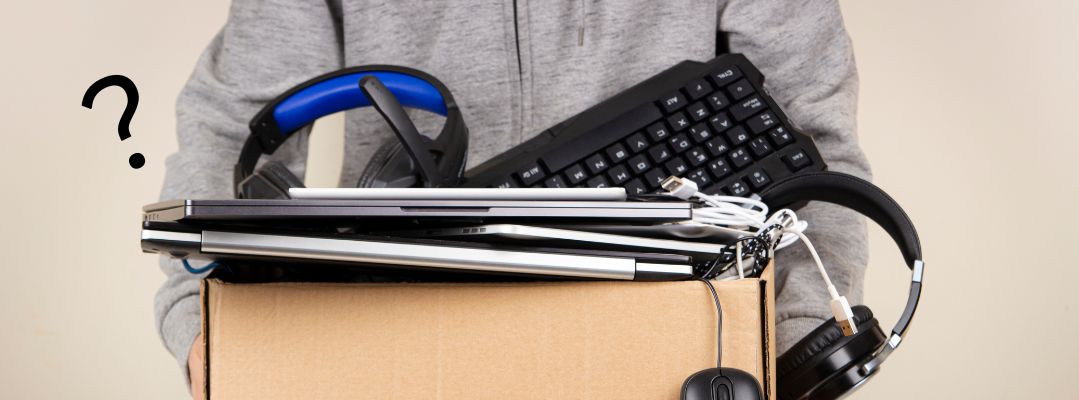Decluttering and Recycling Electronics Before Your Move With Ease

In our lives, electronic devices are quite crucial. We carry these devices around with us everywhere and are dependent on them in many ways. Another crucial aspect of any move is managing your technological equipment. Electronic device organization can help you save a lot of time and money. Your electronic clutter can put you at certain risks, such as home fires, injuries, and identity theft. Our outdated devices are concealed inside our homes since electronic devices frequently upgrade. It is crucial to correctly manage any electronic waste that may exist since improperly discarding our outdated and damaged technology can have a negative impact on the environment as well. So, how do you organize those electronic items while moving to a new location? This blog post will discuss strategies to recycle your electronics and reduce clutter when relocating.
Why is it Important To Declutter Electronics?

Today, all of us have a load of technology in our houses. Electronic device organization can help you save money and time. It is not difficult to gather these gadgets, whether it be a television, laptop, smartphone, or any other device. These gadgets can be useful and entertaining to use, but if not organized properly, they can take up a lot of room. By clearing away your clutter, you’ll be able to organize these outdated gadgets and classify them based on importance. Physical harm may also result from electronic clutter in a number of different ways. For instance, a large object could fall out of a closet and harm someone. Similarly, tripping over a mass of corded electronics might result in serious harm. Fire can also be started by tangled cords and malfunctioning equipment. This is why decluttering electronic devices is crucial.
How To Declutter Electronics?

The task of decluttering can be made much simpler with the appropriate strategy and preparation. Here are some suggestions to help you get rid of your old electronics, including laptops, phones, and other gadgets.
1. Search and Gather All Electronics In Your Home
Start by looking around your home and gathering all of your electrical equipment. You should look in every drawer, closet, and other areas you can think of, then put everything in one place. This stage of the decluttering process is crucial. You might also feel shocked and guilty throughout this stage of the decluttering process, which will make you more aware of how much money you have spent on all these items. Allow yourself to feel these emotions, though, since they are completely valid. Here are a few examples of what should be included in the technological equipment.
- Laptops & personal computers
- Home sound system and speakers
- Headphones & earphones
- Televisions
- Printers
- E-readers
- Tablets & gaming devices
- Cable and cords
- Batteries
- Routers & switches, etc.
This part of the decluttering process may overwhelm you in a lot of ways, so take a deep breath and start. You can also ask your family members or friends to help you with this decluttering process. You can get help from your partner and kids to gather and hand over the electronic items to you.
2. Put Aside the Devices and Chords You Use on a Daily Basis
Laptops, phones, tablets, and other commonly used devices are examples of things you use every day. You might want to save all your electrical equipment after taking a look at the pile of your electronic belongings. However, you must choose the only devices that you truly use, and you must be honest about it. For instance, your mobile phone and those of your family members, laptops, tablets, and home sound system should be separated, as you may need them on a daily basis. Separate the stuff you don’t need anymore. Additionally, you can create a checklist of electronic items and list them by priority. This checklist will make your decluttering process easier by allowing you to distinguish between what to keep and what to discard.
3. Determine What to Keep and What to Discard
Assess each item’s daily usage and determine if it’s necessary for your routine. You must examine each object to see whether it is broken or not functioning, and then separate it into a junk pile. Consider checking outdated electronics like old smartphones or tablets; you might need to locate an adaptor to turn them on. If the gadget won’t switch on after charging, there’s a possibility that it’s completely broken. It will be a great idea to repair and reuse the item if you believe it can function after repair and is worth the expenditure. But make sure to fix it right away rather than putting it back on the shelf. Think about examining your needs by asking yourself, “Do I truly need this item? When have I used it most recently? Do I have another item that does the same job?” Determine whether you actually require the equipment by asking these questions. Even though choosing what to keep and what to throw away can be difficult, doing so will help you manage your technological belongings when moving.
4. Classify Into Categories
Sort and group electronic objects into categories based on how they are used, such as commonly used, shared, outdated, damaged, etc. Individual family members’ devices, including their own smartphones, computers, and tablets, should be kept in a specific pile. Equipment that is used by multiple family members, such as wifi or a shared home computer, should be kept in different piles. Similar to this, important gadgets like home sound systems or smart home gadgets, outdated or broken gadgets that can’t be fixed, etc., should be stored in a separate pile. You will also discover cords, headphones, batteries, and other accessories. Try sorting them into various piles if they are no longer required or compatible with your current gadgets.
5. Verify with Its Owner & Re-evaluate the Pile
If you’re a family member who is decluttering electronic items, you may first need to confirm the items with other family members. Confirm with the individual who is the owner of the equipment or may have used it in the past if you are unsure about a certain item that is not yours. Re-evaluate all the piles after sorting and verifying that they are complete to ensure that nothing is missed. Double-check to make sure everything is in the right pile. You’ll feel extremely at ease and have a sense of accomplishment once you’ve finished this stage of the decluttering process.
6. Decide What to do with the Stuff you Don’t Wish to Use
The final step is to decide what you’re going to do with the items you no longer wish to use after decluttering and organizing all of your electronic equipment. You could believe that the items that are broken and do not work are worthless; however, the devices can still be used to obtain the part that is difficult to find. There are several options, including recycling, donating, and selling those items. You can easily find any repair or recycling store for those electrical items by just running a simple Google search. If you no longer intend to use electronic equipment, you might also think about selling it to make some extra money. Decide what you genuinely want to do with the electrical goods you don’t want to use after assessing their condition.
How To Reuse & Recycle Electronics

1. Sell or Donate Functional Electronics
If your electronics are still in working condition and you no longer need them, consider selling or donating them instead of recycling them. You can use online marketplaces, classified ads, or local community groups to find potential buyers or organizations that accept donations.
2. Recycle Non-functional Electronics
For electronics that are no longer functional or beyond repair, recycling is the best option. Contact local recycling centers or programs to inquire about drop-off locations or scheduled pickups. Some facilities may have specific procedures or guidelines for accepting electronics during a move.
3. Recycle By Mail
Some recycling programs offer a convenient option to recycle electronics by mail. These programs typically provide you with a prepaid shipping label and packaging materials. You can securely pack your electronics and send them to the designated recycling facility. This option is particularly useful if you don’t have a local recycling center or if it’s more convenient for you to ship the items.
4. Drop-Off or Trade-In
Many electronic retailers, such as Best Buy or Staples, offer drop-off or trade-in programs for electronics recycling. They often have designated collection points within their stores where you can bring your old electronics for recycling before moving house. Some retailers may even offer incentives, like store credit or discounts if you trade in your old device for a new one.
5. Electronics Companies
Some electronics manufacturers have their own recycling programs or partnerships with recycling facilities. They may accept their own brand’s products for recycling or offer take-back programs where you can return your old electronics. Check the manufacturer’s website or contact their customer support to inquire about their recycling options.
6. Scrap Metal Companies
Older electronics, in particular, contain a variety of priceless metals like copper, gold, and silver. Electronic equipment is frequently accepted for recycling by scrap metal businesses in order to reclaim these precious elements. You can look out for nearby scrap metal businesses and find out if they take electronics by contacting them. However, keep in mind that some devices could have dangerous components, so it’s crucial to make sure the recycling process is done properly to minimize any negative effects on the environment.
7. Dispose of Old Cables and Accessories
You might amass a collection of used cables, chargers, and accessories in addition to devices. These goods are accepted by many recycling programs as well. Depending on the rules of the recycling center, bundle them or keep them apart.
8. Repair and Reuse or Gift
If your electronics have minor issues or are not functioning optimally, consider repairing them before deciding to dispose of them. Engage a professional repair service or use online resources and tutorials to troubleshoot and fix the issues. Once repaired, you can continue using the electronics yourself or consider gifting them to someone who could benefit from them. Repairing and reusing electronics not only reduces e-waste but also saves the resources and energy required for manufacturing new devices.
Conclusion
Decluttering and recycling your electronics before you move not only helps you lighten your load but also reduces e-waste and promotes environmental sustainability. By taking an inventory, donating or selling working electronics, repairing and reusing items when possible, and responsibly recycling those that are beyond repair, you can ensure a more organized and eco-friendly move. When considering recycling options, it’s crucial to choose responsible recycling methods that comply with local regulations and prioritize environmental sustainability. Ensure that the chosen recycling facility or program follows proper procedures to handle electronic waste and dispose of hazardous components safely. Additionally, if you’re in need of reliable moving services, consider Harry The Mover, a reputable moving company that can assist you with your relocation needs. Our expertise and professionalism can make your move smoother and more efficient. Remember, prioritizing decluttering and responsible recycling of electronics is a responsible choice that benefits both you and the environment.



